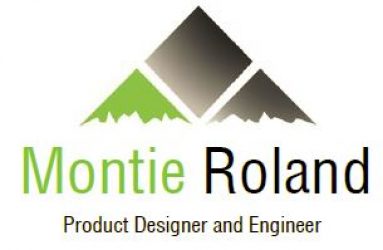—- Transcript ——————————-
Audio File: 2014 Feb 12 – Growing Montie Design or Your Business.mp3
Audio Length: 13:10 minutes
Hello, my name is Montie Roland and I’m with Montie Design in Morrisville, North Carolina. We’re a product development firm and we have core competencies in mechanical engineering and industrial design. And we, basically, take concepts and turn it into products that are ready to be manufactured. And then help clients take it through the manufacturing process to where there’s products on the dock.
So, one of the things about being a design firm is that we have to be responsive to clients, but at the same time, design is an industry that in some ways is very similar but other ways changes rapidly. As business conditions change, we have to change our business with it.
One of the things I’ve been doing for the last few months is to sit back and say – How do we grow to the next level? We’ve kind of been at a similar size for a little while and we’ve determined that we want to achieve some goals. And so, in the process of evaluating where we are, I also realized that, Hey, I need to grow as well. I think anytime the president of a company is not willing to grow, that company’s got problems. So, I’ve been taking classes and getting help from mentors and one of the companies that’s helped us a lot is a company called 360º Profit Masters. And so what they’ve done is they’ve helped us restructure our books and also mentored us through how to better look at our customer segments. And also how to restructure our books around the customer segments we’ve identified, that we serve. Which was definitely a challenging proposition to do for yourself. It’s one of those things. Doing it for somebody else is easy, but doing it for your own business is sometimes interesting.
So, one of the tools that we’re now exploring and working on how to implement is to start looking at our sales process in a more structured way. We have a process now that is very much focused on, you know, what are the client’s needs; how do we meet those needs; and what’s the cost. But, in the past few weeks, I’ve learned that maybe we need to look at this differently, because I think that sometimes it’s really easy just to focus on what you’re good at. And focus on things like, you know, how many hours of engineering for this and that. But, when it comes down to it, as part of the sales process that’s only part of the ballgame. So, we’ve got different sections of that sales process, and some things get done intuitively and are just standard practice. But, I think it’s important that we start to document that so that, A) our results are consistent, and it also protects our profitability (and I’ll explain why in a minute); and then also, too, as we grow that gives us the capability to train a salesman much easier.
So, when we think about a job, let’s say that we’re going to do a project where the client’s right down the street; it’s something we’ve done a hundred times before; we have a good relationship with the client, they always pay on time – everything’s just wonderful. So, that’s a job that we can jump in and knock out. Get a good idea of, you know, what the pitfalls are because we’ve been there before, and that’s great. But then there’s other times where we have jobs where there may be other criteria that become important to how the job is performed, which inevitably affect the bottom line and should be considered in the quoting process. So, for example, issues might range from, you know, concerns about payment, to where the job’s located. If we’re doing a project and I’ve got to put four guys in the Himalayas for six months, there’s a cost associated with that. So, I need to consider that cost when we’re looking at how we’re going to price the job. So, one possible tool we’ve been looking at is to develop a baseline score based upon historical data of job profitability. So, let’s say that we figure out that the average job, we have this baseline score of 50. And based upon the size of the job and that score, we should end up with a profitability of X. And so that is the starting place. The next step is then to identify things that impact that score. So, for example, I take that score and I start going through a list of questions. Is this client local? Is this client in the state? Is this client, you know, out of state? Is the client out of country? Do we have to travel to the client’s facility? Is this an industry or a construction method (a construction method – you know, maybe sheet metal, injection molding, die casting); we’ve done a lot but is this something we do have a lot of experience in? Or we don’t have a lot of experience in? Is this an industry we’ve never worked in? Are there language barriers? These type questions and go through these questions, and then assign a modifier for each one. So, for example, if there’s an extreme location – an extreme location can be a difficult to reach location physically, or it could be an extreme location like, you know, some place out of country that isn’t safe; and there’s a range of stuff in-between. So, as we go through and ask each question, previous to this job that we’re quoting, we’ve assigned a value to each question. So, is the client in town? Okay, maybe that’s a +5. Is the client less than fifty miles? Maybe that’s a +0. Is the client more than fifty miles? Maybe that’s a -1. Is the client out of state and will require visits? Well, maybe that’s a -10. Because even if we bill for that travel expenses, there’s always some downtime associated with that. Somebody’s gone for half a day and they get back at 2:30; a day’s lost. So we go through and develop this score and then this score allows us to see where the job should fall for profitability, and from a pain-in-the-butt standpoint. Some jobs are just going to tie up resources that maybe would be better used on a job that’s easier. Maybe easier’s not the right word; maybe a job that’s more of a standard project, as much there are in design. But that way we’ve got a way to evaluate that. We’ve also got a way to start involving employees in the quoting process, which I think is important especially because those employees affect the profitability of those jobs. So if they understand better the quoting process then, all of a sudden, they have a better understanding of how they can impact the profitability, which is just a great way to help lead to more profitability because your employees and maybe even vendors have a clear understand of things that they do that adversely or positively affect that job, and then as a result, the help to the company which, they have a personal interest in.
So, that’s a tool we’ve been looking at. There’s a lot of work between here and there. But, I think we are on the positive path as we’re automating our sales process, or better defining our sales process. And that way, too, it also helps anybody who’s involved in that sales process to not forget an important step. In the challenges, you don’t want it to become so automated that, or so rote, that all of a sudden important factors are not considered because they’re not on a checklist. So there’s got to be a balance between the two. But that’s kind of what we’re doing. I think that a similar process could be applied when you’re deciding what type of product you should sell. And I’m on a little bit of a tangent here, but when you’re thinking about adding another product to your product line, or maybe doing your first product, then there’s this opportunity to evaluate – Should you do this product? but way before you start manufacturing it. So, I think you could apply a similar process to each product. And this is a little more than “house of quality” because in house of quality, we’re just concerned with feature sets. But in this case, we’re starting to look at the product more holistically and can be concerned with the financial side of that, but structure it in such a way that it doesn’t require a CPA to figure that out. That’s something I imagine we’ll explore over the next year, as far as tying that especially into our Montie Gear products. And developing that model of evaluating products early on and maybe standardizing how we do that for Montie Gear, which will let us turn around and do the same thing for clients where that’s needed.
So I hope this has been a beneficial chat. You can tell it’s something that I’m thinking about and working through. So I’m sure over the next few months, I’ll have other thoughts. But I do appreciate you taking time to listen to the podcast. I hope its beneficial. I hope we can help your business. I hope we can help you design better products or manufacture better products. If you have any questions or comments, or, Hey! If you need a really good design firm to help make your next product a success, any of the above, give me a call – Montie Roland, 919-481-1845. Email me – montie (M-O-N-T-I-E)@montie .com. Or visit our website – www. montie.com. I appreciate your time. Have a great day. Montie Roland, signing off.
END AUDIO

